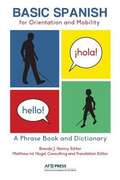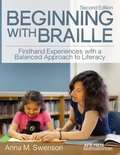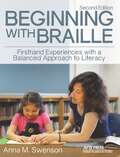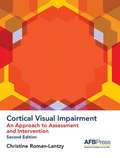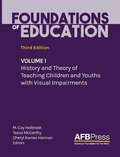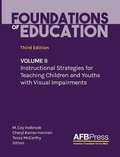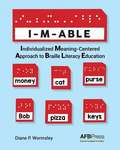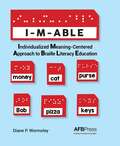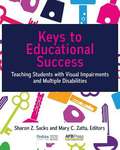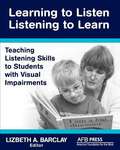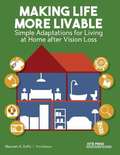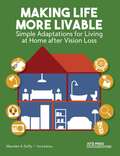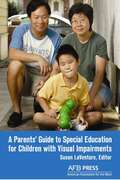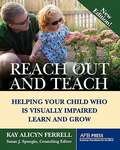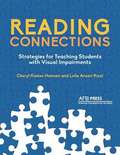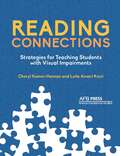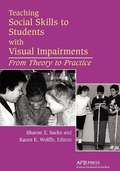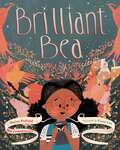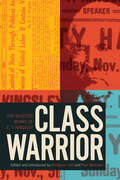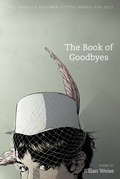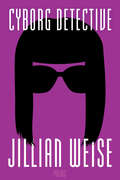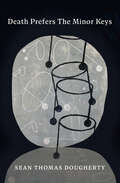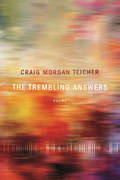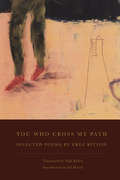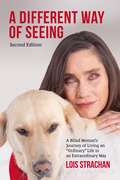- Table View
- List View
Basic Spanish for Orientation and Mobility: A Phrase Book and Dictionary
by Brenda J. NaimyProfessionals providing services to people who are visually impaired work with individuals from broadly diverse ethnic, religious, and cultural groups. Many speak languages other than English. Basic Spanish for Orientation and Mobility is a new user-friendly, valuable tool for communicating O&M instruction to students who primarily speak Spanish. This handy and comprehensive manual provides O&M lessons broken down step-by-step and displayed side-by-side in English and Spanish. It also includes phrases and O&M terminology needed to convey instruction, and easy-to-read vocabulary lists
Beginning With Braille: Firsthand Experiences With A Balanced Approach To Literacy
by Anna M SwensonBeginning with Braille, the illuminating classic written by a master teacher and beloved by readers in the United States and abroad, has been expanded and revised This exceptional resource that has been an essential guide to helping educators teach braille to readers who are visually impaired contains invaluable new sections on a range of critical topics, including trends in general education literacy instruction and the teaching of braille, working with dual-media learners, and addressing diverse needs effectively. Updated with UEB, the second edition also includes new teaching materials, record forms, and braille activities.
Beginning with Braille
by Anna M. SwensonWritten by a gifted practitioner, Beginning with Braille offers teachers a variety of practical strategies for designing and delivering braille instruction. This guide emphasizes the balance between a meaning-centered approach and braille reading skills for early literacy and beginning readers and writers, as well as children with multiple disabilities. It provides suggestions for reading aloud to young children, selecting and making early tactile books, and teaching tactile and hand movement skills, as well as tips on the braille writing process. Reading Beginning with Braille, with its numerous suggestions and examples, is like having a mentor by your side.
Cortical Visual Impairment: An Approach To Assessment And Intervention (Second Edition)
by Christine Roman-LantzyCortical Visual Impairment: An Approach to Assessment and Intervention provides educators, therapists, physicians, and parents of children with CVI with an understanding of the condition and a complete framework for assessment and intervention. The new and revised content in this second edition brings the book up-to-date with new research and insights into CVI, its development and progression, and the best approaches to assessment and intervention with children affected by this condition. As in the previous edition, assessment forms, including the CVI Range and CVI Progress Chart, provide a comprehensive method for evaluating the functional vision status of, and program planning for, children with CVI.
Foundations of Education 3e, Vol 1
by M. Cay Holbrook Tessa Mccarthy Cheryl Kamei-Hannan EditorsThe highly anticipated third edition of the essential textbook in the field of blindness and visual impairment is completely revised and updated for the 21st century. In addition to the latest information and best practices, Volume I, History and Theory of Teaching Children and Youth with Visual Impairments, includes a whole new set of chapters that provide additional perspectives on the educational system and focus on crucial topics that connect the education of students with visual impairment to the broader context of educational theory. Volume II, Instructional Strategies for Teaching Children and Youths with Visual Impairments, contains additional material on planning instruction, moving from assessment to instruction, and supporting students with visual impairments in the general education classroom. Instructional strategies are also highlighted, with chapters dedicated to each area of the core or expanded core curriculum. Icons located throughout both volumes direct readers to audio introductions, chapter overviews, learning activities, videos, resource lists, and downloadable forms housed in an exclusive, web-based Learning Center that enriches this foundational textbook as never before.
Foundations of Education Volume 2: Instructional Strategies for Teaching Children and Youths with Visual Impairments
by M. Cay Holbrook Tessa Mccarthy Cheryl Kamei-Hannan EditorsThe highly anticipated third edition of the essential textbook in the field of blindness and visual impairment is completely revised and updated for the 21st century. In addition to the latest information and best practices, Volume I, History and Theory of Teaching Children and Youth with Visual Impairments, includes a whole new set of chapters that provide additional perspectives on the educational system and focus on crucial topics that connect the education of students with visual impairment to the broader context of educational theory. Volume II, Instructional Strategies for Teaching Children and Youths with Visual Impairments, contains additional material on planning instruction, moving from assessment to instruction, and supporting students with visual impairments in the general education classroom. Instructional strategies are also highlighted, with chapters dedicated to each area of the core or expanded core curriculum. Icons located throughout both volumes direct readers to audio introductions, chapter overviews, learning activities, videos, resource lists, and downloadable forms housed in an exclusive, web-based Learning Center that enriches this foundational textbook as never before.
I-m-able: Individualized Meaning-centered Approach To Braille Literacy Education
by Diane P. WormsleyI-M-ABLE, or the Individualized Meaning-Centered Approach to Braille Literacy Education, is an innovative, individualized, student-centered method for teaching braille and making it exciting for children who have difficulties learning braille. In this teaching approach, instruction is centered on continuously analyzing the strengths and needs of students, placing particular emphasis on engaging them using key vocabulary words and phrases based on their experiences and interests. This comprehensive practice guide provides detailed direction on how to implement the components of the approach. Teachers will find this resource invaluable for helping students with mild to moderate cognitive impairments or other difficulties make progress in braille reading and writing, and all the skills that it encompasses.
I-m-able
by Diane P. WormsleyI-M-ABLE, or the Individualized Meaning-Centered Approach to Braille Literacy Education, is an innovative, individualized, student-centered method for teaching braille and making it exciting for children who have difficulties learning braille. In this teaching approach, instruction is centered on continuously analyzing the strengths and needs of students, placing particular emphasis on engaging them using key vocabulary words and phrases based on their experiences and interests. This comprehensive practice guide provides detailed direction on how to implement the components of the approach. Teachers will find this resource invaluable for helping students with mild to moderate cognitive impairments or other difficulties make progress in braille reading and writing, and all the skills that it encompasses.
Keys to Educational Success
by Sharon Z. Sacks Mary C. Zatta EditorsEvery student has unique learning needs, but addressing the diverse needs of students who have visual impairments and multiple disabilities can be particularly challenging for teachers. Keys to Educational Success helps educators unlock the learning potential of their students by providing key program strategies that can be directly applied to classroom learning routines. It includes information about the basics of assessment, IEP development, and instructional planning and design, as well as specific strategies for essential areas of instruction including communication, literacy, O&M, behavior intervention, technology, and others. Guidelines for working with very young children, as well as for preparing students for life transitions after school, are explained. Keys to Educational Success is also an important reference for special education teachers, educational team members, and administrators.
Learning to Listen/Listening to Learn
by Lizbeth A. BarclayLearning to Listen/Listening to Learn is the first comprehensive work to address the systematic development of skills in listening for and interpreting auditory information for students who are blind or visually impaired. Listening skills are a crucial but often-overlooked area of instruction for children who are visually impaired and may have multiple disabilities, essential to literacy, independent travel, and sensory and cognitive development. Chock full of practical strategies, this volume examines the development of and instruction in learning skills at different ages, from infancy through high school. It also addresses listening skills in orientation and mobility and the needs of children with multiple disabilities, hearing impairment, and learning disabilities, as well as English language learners. Appendixes provide a Listening Skills Continuum chart and a checklist to use in assessment.
Making Life More Livable: Simple Adaptations For Living At Home After Vision Loss
by Maureen A. DuffyFor more than 30 years, Making Life More Livable has served as an indispensable resource for older adults with vision loss and their families, providing practical tips and easy adaptations and modifications for improving the safety and security of older adults in their homes. The revised and updated third edition includes information on current technology and independent living products, as well as an updated Resource Guide, in addition to general guidelines and room-by-room specifics. A brand new chapter describes basic skills for moving around safely inside the home and provides suggestions for preventing falls. The chapter on additional health conditions has also been expanded to include the specific ways each condition affects vision. The newest edition also has a fresh, vibrant look, with color photos illustrating simple and effective solutions for older adults to continue living independent, productive lives.
Making Life More Livable
by Maureen A. DuffyFor more than 30 years, Making Life More Livable has served as an indispensable resource for older adults with vision loss and their families, providing practical tips and easy adaptations and modifications for improving the safety and security of older adults in their homes. The revised and updated third edition includes information on current technology and independent living products, as well as an updated Resource Guide, in addition to general guidelines and room-by-room specifics. A brand new chapter describes basic skills for moving around safely inside the home and provides suggestions for preventing falls. The chapter on additional health conditions has also been expanded to include the specific ways each condition affects vision. The newest edition also has a fresh, vibrant look, with color photos illustrating simple and effective solutions for older adults to continue living independent, productive lives.
A Parents' Guide to Special Education for Children with Visual Impairments
by Susan LaventureThis handbook for parents, family members and caregivers of children with visual impairments explains special education services that these children are likely to need and to which they are entitled--and how to ensure that they receive them. Edited and written by experienced parents and professionals, this helpful and easy to use resource addresses the effect of visual impairment on a childs ability to learn and the services and educational programming that are essential for them to get the best education possible. Chapters address early intervention, assessment, different types of services, IEPs, accommodations and adaptations, different types of placements, children with other disabilities in addition to visual impairment, and negotiation and advocacy.
Reach Out and Teach
by Kay Alicyn FerrellPacked with important information for todays parents and professionals, this new edition of a groundbreaking work presents the latest research on how visually impaired children learn and develop at different ages and in the various developmental domains: sensory development, communication, movement, manipulation, and comprehension. Clear, practical, and reassuring, and full of suggested activities, this book provides a guide to teaching young visually impaired children the important life skills they need to know--skills that other children may learn simply by observation and imitation--and preparing them to enter school ready to learn with their peers. From early intervention services to the full range of educational placements, Reach Out and Teach is the ultimate guide to helping a visually impaired child learn and grow.
Reading Connections: Strategies For Teaching Students With Visual Impairments
by Cheryl Kamei-HannanReading Connections: Strategies for Teaching Students with Visual Impairments offers an in-depth and user-friendly guide for understanding reading instruction for teachers and professionals seeking to improve the reading skills of their students who are visually impaired. The book addresses in detail the essential components of reading--phonemic awareness, phonics, reading fluency, vocabulary, and reading comprehension--as well as other key reading components and subskills. While this book addresses the needs of students who read print, braille, or both, much of the book is also consistent with strategies for teaching reading to students who have, or are at risk for, developing reading disabilities. Teachers of students with visual impairments, as well as family members and other professionals who work with children who are blind or visually impaired, will find within this book a repertoire of strategies and activities for creating a balanced, comprehensive plan of reading instruction for each student and for teaching the essential reading skills necessary for students' success.
Reading Connections
by Cheryl Kamei-Hannan Leila Ansari RicciReading Connections: Strategies for Teaching Students with Visual Impairments offers an in-depth and user-friendly guide for understanding reading instruction for teachers and professionals seeking to improve the reading skills of their students who are visually impaired. The book addresses in detail the essential components of reading--phonemic awareness, phonics, reading fluency, vocabulary, and reading comprehension--as well as other key reading components and subskills. While this book addresses the needs of students who read print, braille, or both, much of the book is also consistent with strategies for teaching reading to students who have, or are at risk for, developing reading disabilities. Teachers of students with visual impairments, as well as family members and other professionals who work with children who are blind or visually impaired, will find within this book a repertoire of strategies and activities for creating a balanced, comprehensive plan of reading instruction for each student and for teaching the essential reading skills necessary for students' success.
Teaching Social Skills to Students with Visual Impairments: From Theory to Practice
by Sharon Z. Sacks Karen E. WolffeHow do children become social beings? When a child is unable to observe visually and imitate how other people react and interact, this complex developmental process can become fragmented and incomplete. As a result, providing specific information, direct instruction, and opportunities for social interaction to children who are blind or visually impaired is critical to their growth and education. Edited by two groundbreaking educators and researchers, with contributions from other outstanding educators and researchers in this area, Teaching Social Skills to Students with Visual Impairments explores what theory can tell us about how children who are visually impaired become socially skilled individuals. It then presents a compendium of techniques and strategies for helping youngsters, from preschoolers through young adults, including those with additional disabilities, develop and refine social skills.
Brilliant Bea: A Story for Kids With Dyslexia and Learning Differences
by Shaina Rudolph Mary VukadinovichAn endearing and empowering story that demonstrates that a learning difference like dyslexia doesn&’t define who you are. Despite her struggles with reading and writing, Beatrice is a natural and brilliant storyteller. With the help of a kind-hearted teacher, Beatrice uses an old-fashioned tape recorder so she can speak her words and then play them back, as a technique for learning in whole new way. With her new approach, Beatrice is able to show her classmates who she really has been all along. This book is set in EasyReading, a dyslexia-friendly font.
Class Warrior: The Selected Works of E. T. Kingsley
by Eugene Thornton KingsleyIn October 1890, Eugene T. Kingsley’s life changed irrevocably when he was injured in a fall between two rail cars while working as a brakeman on the Northern Pacific Railway. Following the amputation of both his legs, Kingsley became radicalized and joined the Socialist Labor Party in San Francisco. His activism eventually brought him to Vancouver, B.C. where he founded the Socialist Party of Canada. A self-described “uncompromising enemy of class rule and class robbery,” Kingsley wrote prolifically on the exploitation of wage slaves by the capitalist class. Also known as a passionate orator, he went on to become one of the most prominent socialist intellectuals of his day. Class Warrior is a collection of Kingsley’s writing and speeches that underscores his tremendous impact on Canadian political discourse.
The Book of Goodbyes (American Poets Continuum)
by Jillian WeiseWinner of the Isabella Gardner Poetry Award The Book of Goodbyes speaks to a certain deranged love that throws into question sex, legality, gender-politics, disability, and the end of an affair. The book shifts between lyric and narrative, hyper-realism and magical realism, fact and fiction, and is organized like a play with Act I, Intermission, Act II, and Curtain Call.
Cyborg Detective (American Poets Continuum #174)
by Jillian WeiseIn her third collection of poems, Jillian Weise delivers a reckoning to the ableism of the Western Canon. These poems investigate and challenge the ways that nondisabled writers have appropriated disabled bodies, from calling out William Carlos Williams to biohacking Raymond Carver’s “Cathedral” to chronicling the ongoing headlines of violence against disabled women. Part invective, part love poem, Cyborg Detective holds a magnifying glass to the marginalization and fetishization of disabled people while claiming space and pride for the people who already use technology and cybernetic implants every day.
Death Prefers the Minor Keys
by Sean Thomas DoughertyIn his twentieth book, most of which was first composed on the backs of medical forms while on break as a third-shift medical technician, Sean Thomas Dougherty brings us a memoir-like prose sequence reflecting on disability, chronic illness, addiction, survival, love, and parenthood. In Death Prefers the Minor Keys, Dougherty offers the reader collaged prose poems, stories and essays full of dreams, metaphors, aphorisms, parables and narratives of his work as a caregiver. Moving portraits of Dougherty’s residents, a series of letters to Death, invocations of Jewish ancestry through the photography of Roman Vishniac, imaginary treatments for brain injuries, and half translated short stories of lives both real and imagined populate this collection. Through these, Dougherty engages issues of labor, the ontology of disability, and the mysticism of life. Death Prefers the Minor Keys is most of all a kind of love letter to Dougherty’s wife, and her courage and complicity in the face of long-term illness and addiction. Ultimately, we see how the antidote to despair can reside in daily acts of caring for other human beings.
The Trembling Answers (American Poets Continuum)
by Craig Morgan TeicherWINNER OF THE 2018 LENORE MARSHALL POETRY PRIZEAn extension of and a departure from previous explorations of family and art, these poems delve boldly into tangled realities of fatherhood, marriage, and poetry. Dealing with the day-to-day of family life—including the alert anxiety and remarkable beauty of caring for a child with cerebral palsy—these personal narratives illuminate the relationship that exists between poetry and a life fiercely lived.
You Who Cross My Path: Selected Poems By Erez Bitton
by Erez BittonThis first US publication of Erez Bitton, one of Israel's most celebrated poets, recalls the fate of Moroccan Jewish culture with poems both evocative and pure. Considered the founding father of Mizrahi Israeli, a major tradition in the history of Hebrew poetry, Bitton's bilingual collection dramatically expands the scope of biographical experience and memory, ultimately resurrecting a vanishing world and culture.Preliminary Background WordsMy mother my motherfrom a village of shrubs green of a different green.From a bird's nest producing milk sweeter than sweet.From a nightingale's cradle of a thousand Arabian nights.My mother my motherwho staved off evilwith her middle fingerswith beating her cheston behalf of all mothers.My father my fatherwho delved into worldswho sanctified the Sabbath with pure Araqwho was most practicedin synagogue traditions.And I—having distanced myselfdeep into my heartwould recitewhen all were asleepshort Bach massesdeep into my heartin Jewish-Moroccan.Erez Bitton was born in 1942 to Moroccan parents in Oran, Algeria, and emigrated to Israel in 1948. Blinded by a stray hand grenade in Lod, he spent his childhood in Jerusalem's School for the Blind. He is considered the founding father of Mizrahi poetry in Israel—the first poet to take on the conflict between North African immigrants and the Ashkenazi society, and the first to use Judeo-Arabic dialect in his poetry. His most recent award is the Bialik Lifetime Achievement Award (2014).
A Different Way of Seeing: A Blind Woman's Journey Of Living An Ordinary Life In An Extraordinary Way
by Lois StrachanEndorsed by the South African National Council for the Blind, and the South African Guide-Dogs Association for the Blind. Have you ever wondered how a blind person pours a cup of coffee? Or how they and their guide dog know when it’s safe to cross a busy road? When Lois Strachan lost her sight at the age of 21 years, she had to learn the answers to these and countless other questions of how to live as a blind person in a sighted world. In this delightfully quirky and entertaining book, Lois shares some of the secrets she discovered about how to live an "ordinary" life in an extraordinary way despite her blindness.
